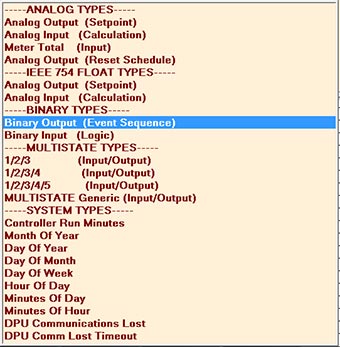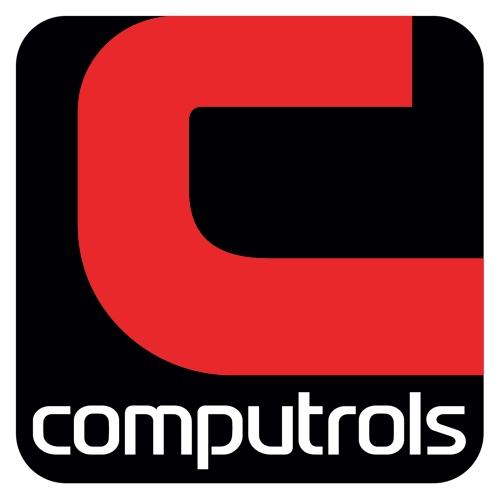 When you add a software point to a controller, you have to choose from a long list of point types.
When you add a software point to a controller, you have to choose from a long list of point types.
In this list, some of the more obvious point types are not shown because the list is scrolled to the bottom. Here’s a brief explanation of the point types on the list.
Analog Output: Some of the most obvious point types are Analog Output (Setpoint) or (Reset Schedule), which are actually the same point type. By going to the point program screen on either of these points, you can convert the point to the other type by clicking a button. A Setpoint is pretty obvious, but a Reset Schedule is used to change your setpoint automatically, based on another input, like an Outside Air Temperature point. To set up a Reset Schedule, add the point and go to the Point Program Screen, then click on the Program Reset Schedule button. From the Reset Schedule Program Screen, you can choose your input point and temperatures.
Calculation: The Analog Input (Calculation) point type is mainly used to calculate a Setpoint Error or an average of several temperature points in a space. To configure this point type, go to the Point Program Screen and click the Program Calc button. The logic is programmed just like any other logic.
Meter Total: The Meter and Meter Total points are used in conjunction with pulse meter Counter points to convert the pulses into usable data like kWh or BTUs. Setting up these points is somewhat complicated and is another complete article. For complete instructions, see Chapter 7, Section 2, Pulse Meters in the Computrols CBAS Manual.
IEEE 754 Float Types
These point types are the same as the previous Analog types except that behind the scenes, they are Floats instead of Integers. This means that the points can represent much larger numbers and are compatible with Modbus float points in calculations.
Here’s the difference between Analog and Analog Float points. If you select Analog Input under Analog Types you get the old Analog Type. If you select Analog Input under IEEE 754 FLOAT TYPES you get the new Analog Float point type. Both points work with logic, but there are differences between the two.
Analog Point type: This point is stored internally as an integer. Its max range is 0-65,000 for unsigned and –32,000 to 32,000 for signed values. When doing logic, the math is done as integer math. An Integer does not have a decimal place. We fake out the decimal place when displaying it to the user. You can set the min and max range on this type of point.
Analog Float Point type: This was added to CBAS just a few years ago. Internally this point is stored as a real floating point number. Not an integer pretending to be a floating point number. A floating point number can represent 7 significant digits. It can have any number of decimal places or store very large numbers and very small numbers. So it can store values that the old Analog point type cannot. But you can’t set the min/max range on this point type. With Analog Float points you also have the option to scale the points value using the point slope formula y = mx + b.
So you can add both types of Analog points to CBAS. There is NO conversion between the 2 Analog point types. If you added it as Analog Float you would have to delete and re-add as Analog.
Binary Types
Event Sequence: The Binary Output (Event Sequence) point type is a good place to put a Schedule, Overtime, or Logic that will control other points or operations. It works just like any other hardware binary output.
Logic: Since this is an Input, you cannot put a Schedule or Overtime on it, but it is a good place to put logic that sets the value of the point itself. Many times this point is used as a status point that monitors amps and can be linked to an output that controls a piece of equipment. It is also used to monitor other alarms and act as a “Master” or “Critical” alarm for a group of alarms.
Multi-State Types
Multi-State points are Output points that simulate 3, 4 or 5 state outputs. They can be used to simulate the standard states of a wall thermostat (Off/ Heat/ Cool). Multi-State software points appear to be supervised points, but they are not. There is also a Generic Multistate point that can have up to 10 states.
System Types
The next section of points is the System Points. The term “System Points” means that the data for these points is derived locally from the system or DPU computer.
DPU Run Minutes: If added to a controller’s database, this point gives you the amount of time the computer on the controller has been running without rebooting. If added to the DPU database, it tells you how long the DPU has been running without rebooting. This point type is mainly used for troubleshooting purposes.
Month of Year, Etc: Month of Year, Day of Week and the rest of the time-related points give you information from the calendar or clock of the DPU operating system. For example, the Month of Year point gives you a 1-12 depending on what month it is, and Day of Week gives you a 1-7 depending on what day it is (Sunday is 1). These points can be used for many things, but here is one example: Suppose you wanted a different schedule for each month to control when outside lighting is on. Create a Month of Year point and an Event Sequence for each month with a different schedule on each one, and add a Binary Out (Logic) with a logic like:
And X Month Schedule Point is ON
Then on Binary Out (Logic) point
Else if (Same thing for next month)
DPU Communications Lost: This point works in conjunction with the DPU Comm Lost Timeout point and is mainly a tool for troubleshooting communication problems. When added to a controller, the Communications Lost point will output a status of YES if there is no communication between the controller and the DPU for a certain time period (default is 10 minutes). The time period is adjustable by commanding the Timeout point to a value (in seconds). You would have to add some logic to this point or another point on the controller to make use of this point because you will never see it from the DPU when it is true.
The possibilities for using these system points are infinite. Use your imagination when programming a difficult sequence of operation and you can probably put some of these point types to use.




